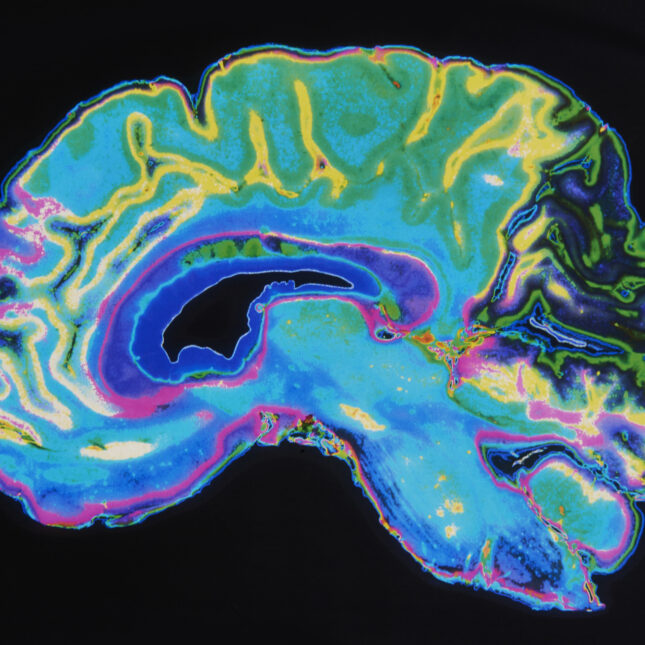
Traumatic brain injury multiplies the risk of major depression eightfold. While the emotional trauma of whatever caused such deep damage may be understandable, from a blast in a war zone to a blow on the playing field, there’s a physiological component, too, that neuroscientists have long suspected but have been unable to identify.
“As clinicians, a lot of us had a gut feeling that [TBI-associated depression] is a different disease,” said Shan Siddiqi, a Harvard Medical School assistant professor of psychiatry and a clinical neuropsychiatrist at Brigham and Women’s Hospital in Boston. “Why did nobody detect it before? I think the reason is because unlike other psychiatric disorders, TBI caused a sort of structural reorganization of the brain.”
Now, thanks to improved imaging techniques and the advent of brain stimulation, there may be a way to first map and then target brain circuits disrupted by TBI that lead to a specific form of depression. Siddiqi led a cohort study that pinpoints a distinct brain connectivity profile in TBI-associated depression, one that was independent of TBI (not all patients with TBI develop depression), major depressive disorder, post-traumatic stress disorder, and depression severity across different types of patients.
Siddiqi talked with STAT about the study, published Wednesday in Science Translational Medicine. This interview has been edited and condensed for clarity.
What’s different about people who have clinical depression after a traumatic brain injury compared to people who have other kinds of depression?
There are actually multiple clinical trials showing that antidepressant medications and antidepressant psychotherapy don’t really work for people’s traumatic brain injury. Certain things are different about them in terms of their symptoms, but nobody’s ever been able to find a physiological difference. There are also certain hypotheses about how their brains might be different, but that’s never been proven.
How are their symptoms different?

Usually in people with major depression, we see inability to experience pleasure. In patients with TBI, we often see difficulty being motivated by pleasurable things, but also difficulty learning from frustration. And these are similar brain networks. Learning from experience of pleasure is largely a dopamine-mediated phenomenon that involves a specific chemical we know about. Pleasure and frustration together involve different neurotransmitters, but they involve the same brain circuits that have a specific anatomical connection that teaches you to learn both from pleasure and from frustration.
Regular major depression may feel like, “I don’t care about anything, I’m useless, what’s the point?” But people with TBI-associated depression, you often see them repeatedly engaging in things that, normally, people would learn and be frustrated from and give up on. For example, they can become impulsive and start getting angry and become easily frustrated by seemingly small things because they’re not learning from the frustration.
What is it about a TBI that causes this?
The hypothesis is that whether it’s a blast injury or even a motor vehicle accident or repetitive head trauma from football, it turns out that it differentially affects the long pathways, the long axons in the brain. Even if you don’t have a physical focal structural injury in the brain — when you have a brain injury affecting the whole thing because of shear stress that almost causes your brain to twist on itself — it causes damage to the longest connections in the brain, which go from the orbitofrontal cortex into the limbic system, a specific circuit. That circuit seems to be disproportionately affected in these patients.
What did your study do?
We set out to try to design a brain stimulation treatment for these patients. In the process of designing that treatment, we had to find the right targets.
So you applied precision functional mapping of brain network connectivity to functional MRI data, and you also previously had done a pilot clinical trial using brain stimulation?
We designed a clinical trial where we did individualized brain mapping to the networks that we hypothesized were involved in TBI-associated depression. And it worked, at least in the pilot study. We only treated about nine patients and five controls, but it worked. And we were excited about this because no other treatment had been shown to work for these people.
But the targets that we used were speculative. It was a hypothesis. We never proved that they were the right targets. One big lingering question that I had in my mind is, before we spend $5 million launching a multi-center clinical trial, I really want to get a little more confidence in the target that we’re using.
Then we did this analysis to try to determine if this network was actually abnormal in these patients. And the more data we looked at, the more we found the same answer.
What did this confirm?
Unlike other psychiatric disorders, TBI caused a sort of structural reorganization of the brain. And because of that, you have to map each person’s individual brain. … We didn’t have that technology until very recently.
Now that we’ve got the technology to map individual brains, we can detect these differences. And we tested that in the study. It turns out that the individualized mapping does significantly better than using sort of group-level assumptions about where the networks are located.
Any caveats?
We didn’t prove that this network is causally involved in TBI-associated depression. The one thing that we still don’t know: Is it damage to the network that’s causing the depression after TBI or is it something else in the healing process that is leading to some sort of damage to this network, as sort of an after-effect or some sort of compensation? That’s something that we want to study, by watching people longitudinally.
One thing that we’d like to do in this longitudinal study is to do a more careful and sophisticated phenotyping so that we can get a more clear idea of whether there are specific symptom patterns that correlate with these specific connectivity patterns.
How long might that take?
I think the trial will take four or five years at most to run. If it’s successful, then we should be seeing this individualized, personalized treatment in the not too distant future. That’s the individualized, personalized treatment. We already have an FDA-cleared brain stimulation treatment for depression. There are some studies that suggest that it works just as well for people with traumatic brain injury.
I think the fact that this is a distinct disorder is something that we’ve been looking for confirmation of in the clinic for a long time. So I think we can already use that information to help us think about our patients a little bit differently.
What’s the bottom line?
Among clinicians, there is an ongoing debate about when people develop depression after traumatic brain injury, whether it’s related to the physical trauma of the brain injury or the emotional trauma associated with the brain injury. And I think this work adds more evidence in the camp that it’s probably due to the physical trauma rather than the emotional trauma. We’ve seen in the past when we show that certain things have detectable changes in the brain, it influences policymakers to think about them differently.
What do you say to patients?
That there’s actually physical brain damage associated with the depression. I think that that’s important to tell these patients, even though emotional trauma is important, just as important potentially. But then people feel more legitimized when it’s related to the physical trauma.










Exciting news! STAT has moved its comment section to our subscriber-only app, STAT+ Connect. Subscribe to STAT+ today to join the conversation or join us on Twitter, Facebook, LinkedIn, and Threads. Let's stay connected!
To submit a correction request, please visit our Contact Us page.